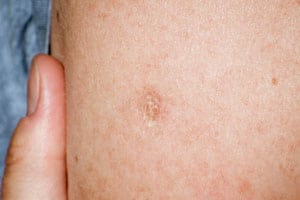May 10, 2021
A Look At BCG
By Michael D. Shaw
BCG stands for Bacillus Calmette-Guérin, and was originally deployed as a vaccine against tuberculosis. 13 years in development (1908-1921), the vaccine is credited to French bacteriologists Albert Calmette and Camille Guérin, and is based on Mycobacterium bovis, a species closely related to the actual pathogen Mycobacterium tuberculosis.
BCG remains to this day the go-to vaccine for TB, but it is mostly used in special circumstances: Broadly, if you are in close proximity to an individual with tuberculosis, and this course has been specifically recommended to you.
Boomers will remember, during their childhood, seeing people perhaps five or more years older than them with a characteristic scar on their arm, as a result of this vaccination. That’s because this vaccine is not injected with a typical syringe. Rather, the active liquid is placed directly on the skin of the upper arm, and is forced into the shallow skin layers with a multi-pronged needle device. A small scar was sometimes left.
BCG may have some therapeutic properties against COVID-19. Based on a study done at Cedars-Sinai Medical Center, those who had received the BCG vaccine in the past were significantly less likely to test positive for SARS-CoV-2 antibodies in their blood or to report having had infections with coronavirus or coronavirus-associated symptoms over the prior six months than those who had not received BCG. Note that BCG was widely used in foreign countries far longer than it was in the US.
The researchers explain that BCG has been linked to generalized infection prevention, and more information on BCG’s properties against COVID-19 has come out recently. Of course, with the availability of specific new vaccines for COVID-19, BCG may not be of such strong interest.
Still, this old drug remains a superstar, based on the notion of cancer immunotherapy, which can be traced back to the work of Dr. William Coley. In 1890, the 28-year-old doctor tried to manage a young woman’s sarcoma, but—given the available tools at the time—failed, and she died early the next year. He was profoundly affected by this, and researched earlier files to discover a case in which a sarcoma completely regressed, once the patient contracted a streptococcal skin infection.
Coley did find this patient, who was alive and well seven years later. Could a deliberate infection promote regression of a tumor? He tried this therapy on a terminal patient with cancer in the neck region, whereby the tumor was injected with the strep bacteria. And he recovered, to live eight more years! Coley was to revise this approach using the less-dangerous heat-killed strep.
As it happens, there was a historical precedent for this sort of cancer immunotherapy. The earliest example of such cancer immunotherapy may be thousands of years old. In the writings of the Ebers Papyrus (ca 1550 BC), attributed to the great Egyptian physician Imhotep (ca. 2600 BC), the recommended treatment for tumors was a poultice followed by incision.
However, with the continuing refinement of aseptic surgical procedure, and the advent of radiation and chemotherapy techniques, which were more predictable and easier to standardize, Coley’s toxins began to lose favor as a cancer treatment. Ironically, one study found that patients who developed empyema after lung cancer surgery had a significantly better five year survival (50%v 18%). Coley’s toxins are believed to have worked in part by binding to and stimulating Toll-like receptors on immune cells, but TLRs were not even discovered until the 1990s.
Dr. Coley would be pleased to know that his oldest form of cancer immunotherapy became the standard treatment for early-stage bladder cancer (high-grade non–muscle invasive bladder cancer), supplanting cystectomy in the mid-1980s. [Seminal paper]. A figure of 70% is given for efficacy, but this can be higher depending on staging.
While not fully understood, the mechanism of action of BCG here is thought to involve a combination of its direct effect on tumor cells along with the patient’s immune response to the therapy. This immune response comprises specific cellular changes including surface receptor changes and release of various cytokines, including interferon.
BCG is widely regarded as the one of the most successful immunotherapies for cancer. Somewhere, Dr. Coley is smiling at us.

